I’m an art collector. Well, no. I fantasize about being an art collector. In my imagination, where I drink a highball every day at five o’clock sharp and go on long vacations to places where the temperature never dips below 70, I’m an art collector. I love art, but I’ve never plucked up the courage to buy much more than a small print here and there, and the long hours I’ve committed to my job don’t give me a lot of wiggle room for learning about art. It’s intimidating.
But in spite of being generally intimidated by the art scene, I’m attending my first First Friday art walk. It’s about time I actually left work on time and took a breather, so I’m strolling downtown with a craft beer in hand, squinting into the glaring late-spring sunset. I look at your display for a few seconds as I stroll past. My smile is friendly but cool, and combined with my mirrored aviators it’s intended to dissuade you, a mysterious artist type, from talking to me. Your display is simple but to the point- I can tell that you do rural farm paintings, and they have an ethereal quality that is enchanting to me. My eyes settle on one piece in particular, a farmhouse in a misty-looking field, and the way you’ve painted the light streaming through the woods! I’m a little surprised that I can’t stop thinking about it. The colors are dreamy and make me feel something warm and safe and optimistic that I don’t think I’ve felt since I was a kid.
I continue down the sidewalk, still thinking about that painting. But, I reason to myself, I’m not really here to buy- I’m intimidated by buying art. That’s something snobby pretentious people do. I’m just here to have a beer, blow off some steam from a 60-hour work week and look at all the pretty pictures. There’s no shortage of charming dog portraits, caricatures drawn on the spot, and highly-detailed pencil drawings of celebrities. They’re all well and good, but something about that farm painting stays in the back of my mind and niggles at me.
I’ve finished my beer and walked the length of the promenade, and finally decide to pay your table one last visit. Sure enough, that gorgeous painting is still sitting there. It’s not huge, about 9×12, but the more I look at it the more I picture it on the wall of my kitchen, next to a photo of Great Grandma. She lived in a modest little yellow farmhouse not unlike the one in the painting. She would let me help her make snickerdoodles and gather the eggs from the chicken coop when I was a little girl visiting her during the long summer breaks. The warm and loving impressions from those early memories are planted deep in my heart.
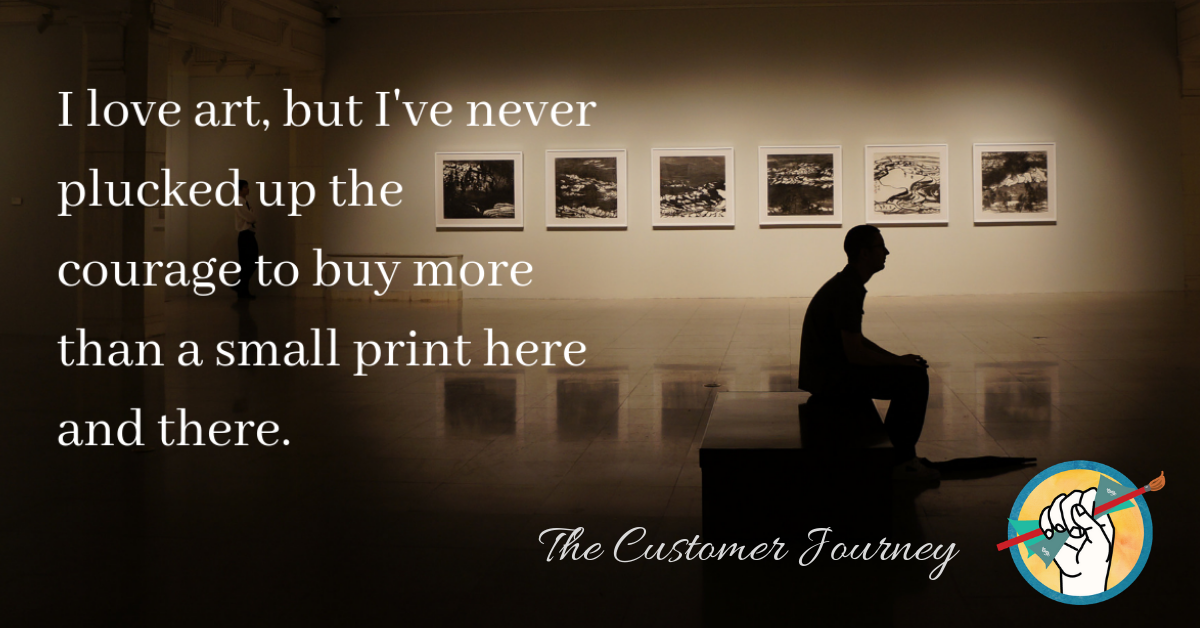
You have obviously noticed me staring at the painting for far longer than a casual observer would. I’m feeling a little embarrassed, but your smile is warm and understanding.
“I painted that one after my dad died,” you say, “He grew up on a farm up in the Pacific Northwest, and he had this thing where he would say the sunlight on the farm shone through the trees like it was coming straight out of heaven. He was a bit of a romantic!”
“It reminds me so much of the farmhouse where my great-grandma used to live!” I reply. “I kinda keep picturing it in my kitchen.”
I burst out in an awkward laugh. I want this painting. But… that’s a lot of money for a pretty picture, isn’t it?
You whip out an iPad and before I know it, we’re looking at the same painting hanging in a warm living room above a huge fireplace, then in the corner of an all-white room with a grand piano, and then on the wall of a cozy modern kitchen.
“That one looks really similar to my kitchen,” I say, and I can already tell that I’m in love with how it looks above the rich wood paneling on the wall. It looks an awful lot like my own kitchen.
I swipe my card through the Square reader before I can talk myself out of it, and I’m a little giddy with excitement- like I actually have butterflies in my stomach. I go ahead and opt-in when the app asks me if you can send me emails in the future. I’m not really interested in an artist newsletter, but your work evoked such big emotions in me at just a glance, I think I’d be happy to see more of it. You send me home with the painting, a postcard, and a warm handshake.
Sure enough, the painting finds a perfect spot on the wall next to the portrait of Great Grandma. Now every time I walk into the kitchen I’m drifting away remembering those long summer evenings: the chirping of the crickets, stargazing in the backyard, that particular sweet-and-sour farm smell wafting by on the warm breeze.
Oh my word, I think, this painting is literally magic.
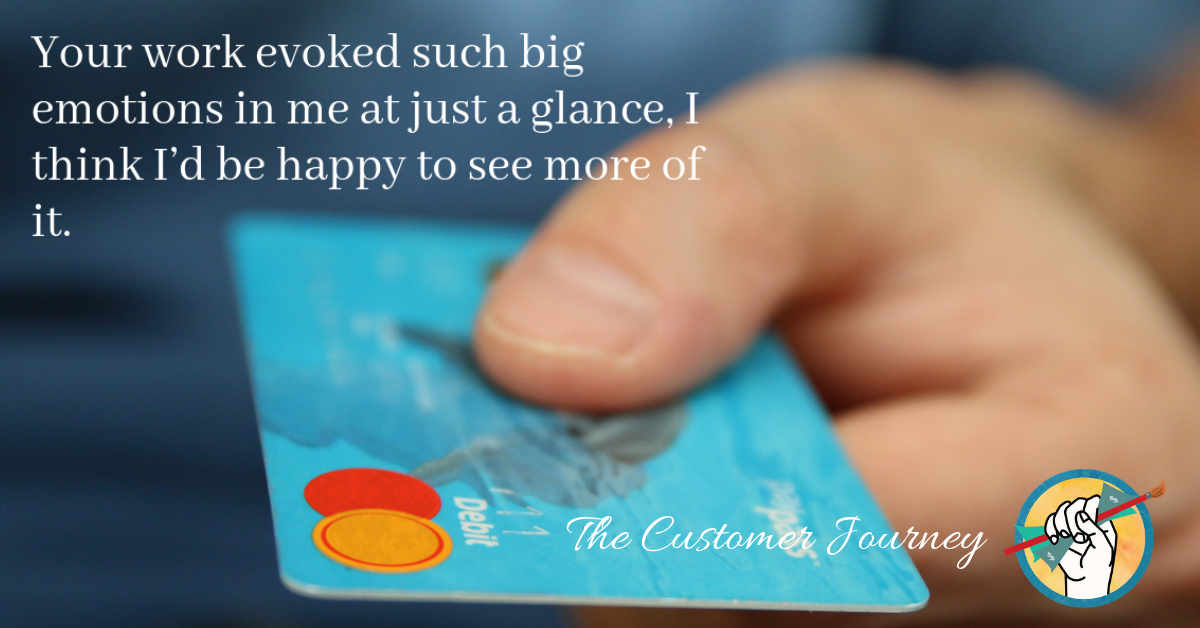
I start receiving occasional emails from you. They’re not salesy at all, which surprises me. Instead you tell stories about the individual paintings: how your dog shook himself against this one and left a scattering of shed hair against the drying paint that you had to painstakingly pick off with tweezers, or how another painting sat in the corner of your studio for three months before a particular shortcut home through a dumpster-lined alleyway, of all things, had you so inspired that you had to rush home and finish it immediately. I expected that you would just be trying to advertise to me, but I find myself liking you more and more as a person. Your writing is a little funny, and you’re very transparent about the surprisingly unglamorous life of a working artist. It’s so outside of my realm of understanding that I never would have expected it, and yet here we are, connected somehow through the love and memories you evoked in me by your work.
I’m also surprised by how much I enjoy the work-in-progress photos. I’m not really a creative type, although I play the guitar a little when I’m not working. But it’s fascinating to see what goes into producing one of your finished works- saving inspiration on a Pinterest board, the pencil sketches, the color studies, the underpainting. Terms like “color study” are completely new to me and it’s a little thrilling to be allowed into your secret world.
Several months in to receiving weekly emails from you, you link to an album of work-in-progress photos on your Facebook page. I click through and like your page. I am not on social media a ton, but I do notice that you like to share when happy collectors post pictures of your work. Hey… I’m a happy collector too! I snap a picture of the painting the next time I’m in the kitchen, and post it on Facebook. I tag you and also my mom and my brother: “I can’t believe how much this painting looks like Great Grandma’s farm! So happy to have it hanging right next to her. Sweet memories. 🙂 ”
In the morning you’ve shared it to your own page: “THIS is why I do what I do. Who would have thought that the painting inspired by my Dad’s old memories of growing up on a farm would resonate so much with someone else in the world? It’s pure magic! Thank you so much for sharing, and do enjoy!” That’s what I said, I think. It’s magic.
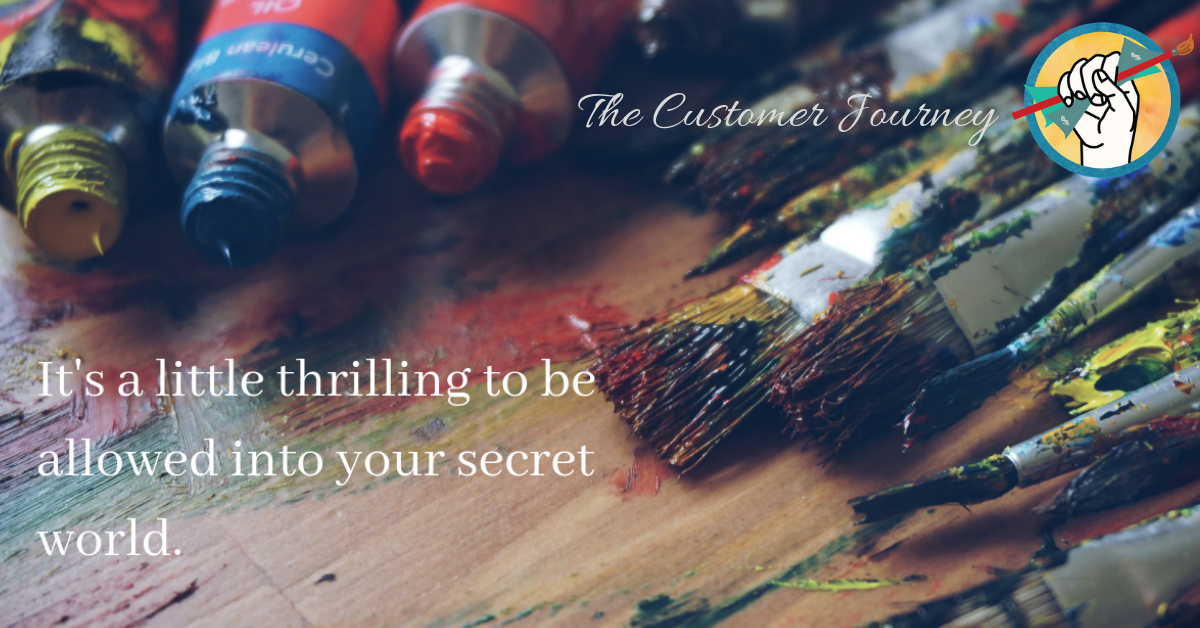
A few months go by, and work is crazy, so I’m not opening very many extraneous emails right now. But out of the blue I get an invitation to an event from you on Facebook, as well as a private message inviting me to the opening of your new show next month. Having been welcomed in to your world bit by bit for the past few months, I’m feeling less intimidated and more excited by the notion of an art event. And I do seriously need a break. I come to your show opening, sip a little wine and seriously enjoy looking at your new pieces and chatting with you. You feel more like a friend now, and I’m sincerely hoping your show does well. I can’t believe I’m doing it, but I purchase another piece. It’s a little larger than the first, but I have to have it. It seems like it’s just a different view of the same painting I already have- but this one is a view of the farmhouse from a low perspective in the grass, and it reminds me so much of laying in the cool grass on a summer evening and idly squeezing the milk out of dandelion stems that I can almost smell the sharp green scent and feel the prickle of the grass on my skin. I’m enchanted. You tell me that both of the paintings I’ve purchased are from a larger series of paintings you’ve titled “Dad’s Farm”, and I joke that I’m going to go broke buying the whole series from you eventually. We laugh, but I’m calculating the dimensions of my available wall space.
I decline a weekend trip with some coworkers a few weeks later, and when pressed I admit that I’m setting aside some money to buy my next painting. My friends gently tease me about becoming a snooty art collector, but when I show them a picture on my phone of the works gracing my walls, they agree that I probably need at least one more to complete my collection. At least. One of them likes your Facebook page on the spot and sends your website link to her aunt, who collects pictures of old barns.
My parents still own the farm property where I used to spend summers with Great Grandma, and it is much to my dismay that I discover they plan to sell it- they’re too old to care for it properly, and neither I nor my siblings can commit the time due to our work schedules. I’m ruminating on it for months, feeling sad and a little sorry for myself. When mom and dad announce they have a buyer, I go over to the property one last time to take some pictures as a final memento. The farm house is pretty run down now and I’m fairly certain the buyers are going to bulldoze it and build something new, bigger, and shinier in its place. A travesty. I snap pictures of the rusted-out antique wheelbarrow next to the overgrown flower beds, the faded and peeling blue paint on the rough wooden walls of the chicken coop, and the tree swing that’s nothing but a flat board and some rope. That rope made a particular creaking sound (I can still hear it) as my nine-year-old self twisted the swing around as tightly as I could and then let go, feet flying, spinning in rapid circles and watching the world whir by in a blur.
A year later now, I’m attending the First Friday art walk again with a friend, and when I see you there I am stricken with an idea. I smile and chat with you for a while, but can’t work up the nerve to bring up the idea then and there. Later that evening I go to your website. Sure enough, there’s a tab that says “Commissions.” Based on your pricing, what I want is going to cost me $6,000. My stomach does a few flip flops, but in my heart there’s so much more at stake than money. There’s the honor and the memory of a precious place that will soon be unavailable to me. I think about how I might move things around… both in my bank account and on my walls.
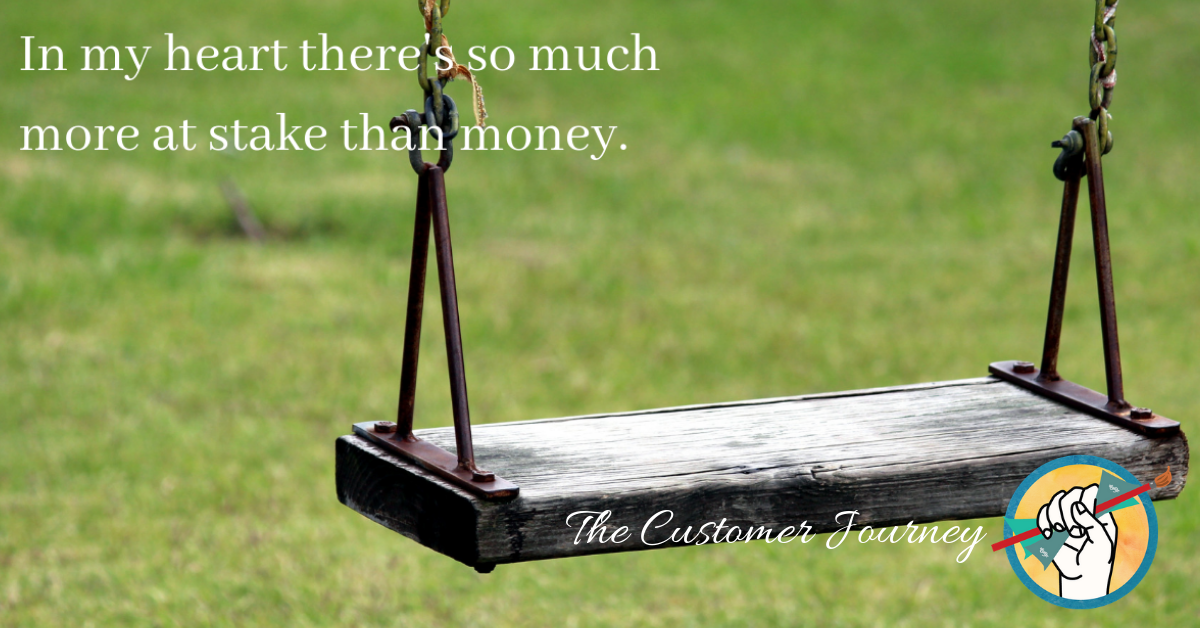
I get ready to send you an email, but first I do a quick Google search. Darn it if I’m not going to try to sound like I have half a clue what I’m talking about. I search “three paintings in a row that go together.” Ah, there it is! A triptych! That’s what I want. A large triptych in my living room of the antique wheelbarrow, the chicken coop, and the tree swing. With that golden late-afternoon light you’re so skilled at painting. The ultimate tribute to the loving woman and the enchanting home that made such an impact on me. I type out the email and try to act real casual about asking for a $6,000 commission based on photos of old rusty farm equipment.
I am second guessing myself as I wait for your reply. $6,000 isn’t chump change. Is it fiscally responsible to spend that much money on something that isn’t necessarily going to mean much to anyone else? Not that I would ever want to turn around and sell something so precious, but it’s the kind of thing you need to think about before spending such a large sum… especially on an item that isn’t, as it were, a necessity. And yet I know that the uneasiness in my heart about the property leaving our family isn’t going to be resolved until I have the perfect way to memorialize it and all the beauty and sweetness it represents to me. And I already know that I’ve found the perfect way in your artwork.
You finally reply- you’re booked out on commissions for the next three months, but you’d like to start discussing and get me into your calendar! I’m both anxious and relieved about the delay. Anxious because I’m afraid I might chicken out and change my mind, and also because I want my triptych NOW. But I’m also relieved that there’s a bit of breathing room to allocate the funds in a responsible way. I’m a little nervous that you’ll be unimpressed with my vision, but when you call me to discuss the commission over the phone, the warmth and excitement in your voice begins to melt my fears. Who would ever have thought that I’d be pitching a creative idea to one of those mysterious artist types I used to so staunchly avoid?
As far as being involved in the process, I mostly want to send you the photos and let you go to town. I already own several of your original pieces- I guess that makes me an art collector!- and I trust you with my vision. Still, you send me a simple contract as well as several color palettes to choose from and you promise to send me abundant photos of the work in progress. The rational part of my brain is grateful for the contract to spell out exactly what I can expect to receive for the substantial amount I’m paying. I pay you half of the final cost up front, and when the smoke clears from my checking account I settle down to await the work in progress photos… which should be arriving three months from now.
In the meantime I clear a space on my living room wall, right above the fireplace. I measure and measure again. And when you finally start work on my triptych, I begin to receive regular emails from you with images of the progress. Pencil sketches. A small color study, which looks perfect enough to me to be sold as-is, although about a third of the size of the finished pieces! And then the work begins on the actual canvases. I’m entranced by the process of working a blank canvas from white nothingness to layer upon layer of paint that gradually begins to take the shape of objects so meaningful to me. I almost can’t believe I’m getting all of this behind-the-scenes stuff for free. I’m excited and proud to see a timelapse video of you painting one of the canvas panels on your Facebook page. The swing! I share it with everyone.
And finally the day arrives. With a commission of this magnitude, you insist that you come to install it yourself. You’ve wired the canvas yourself with steel wire and eye screws, and after a flurry of measurement, pencil marking, and nail pounding, there it is! Each of the three pieces is two feet by three feet, and the final effect is stunning. I can’t stop smiling! We take a few pictures of you and me with the finished installation, and you leave me to sit in silence and look at my new art.
I am surprised at the painlessness of the entire process, and the journey that I’ve been on over the past two years, from feeling intimidated and reticent about ever purchasing art to commissioning something original. There isn’t another piece like this anywhere else in the world, and the idea fills me with warmth. And, of course, as I look at the triptych I’m transported back to the farm. The property itself has been sold and is forever unavailable to me now. But the bitterness is mixed with an unexpected sweetness, as I gaze at the wheelbarrow, the chicken coop, and the swing. They’re symbols of innocence, love, and a more peaceful and carefree time. And I never would have had this chance at preserving these memories in my living room if it hadn’t been for that art walk two years ago where I met you! I’m so glad I took a chance and embarked on this journey!
The Typical Customer Journey
While the customer journey will vary significantly, this story provides a framework for what a typical customer may experience when they purchase a piece of art, from their first encounter with a new artist all the way to purchasing or commissioning a high-end piece for thousands of dollars. It’s essential that as an artist, you understand this journey from the perspective of a customer: that each potential customer is approaching your artwork with their own history, baggage, fears, hesitations, preconceived notions, and desires. The better you understand this, the better you can pacify their fears, appeal to their hopes, and win lifelong customers and raving fans.
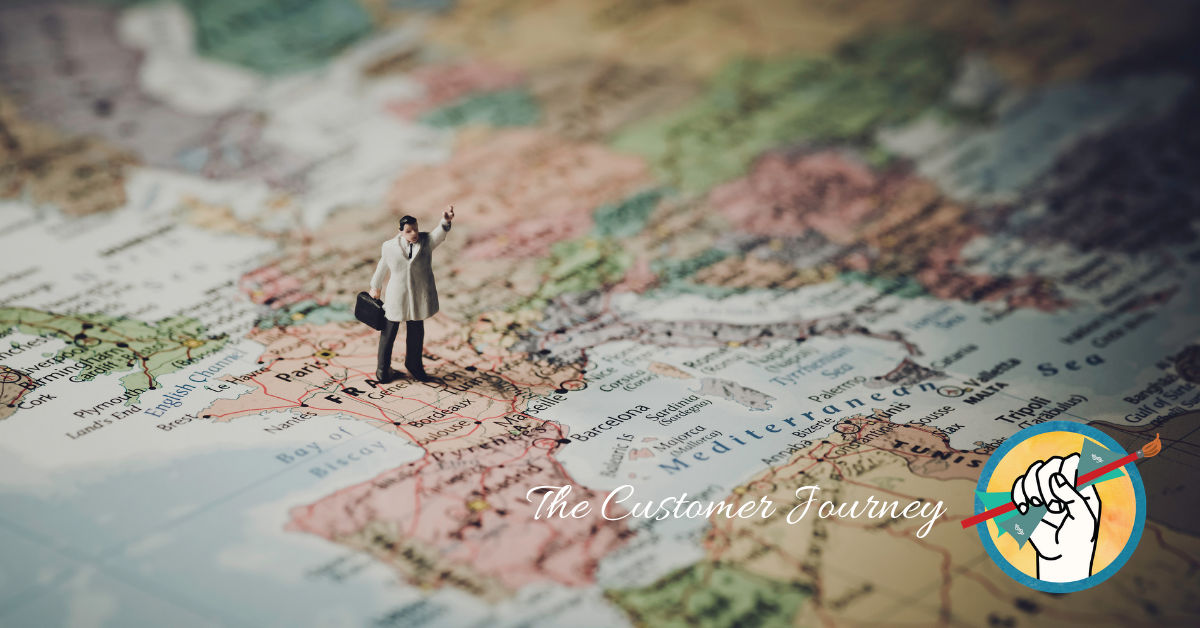
The First Impression
“Your display is simple but to the point- I can tell that you do rural farm paintings, and they have an ethereal quality that is enchanting to me. My eyes settle on one piece in particular, a farmhouse in a misty-looking field, and the way you’ve painted the light streaming through the woods! I’m a little surprised that I can’t stop thinking about it.”
This is a customer’s first exposure to your work, when your work enters someone’s awareness for the first time. This may happen in person at a gallery or art walk like the story above, or it may be a quick glance on social media. Most customers will not purchase at this juncture, though they do in the story above for the sake of brevity. In fact, the general rule of thumb for sales is that a customer needs to be exposed to you 8 times before they make a purchase.
How to leverage the first impression
The first impression you make is powerfully important. You can’t control other people’s reactions to your work. Whether someone likes or dislikes your style and subject matter is out of your hands, but you can present yourself and your work in a positive, memorable light by making sure that:
- your branding and your story is cohesive
- your work is displayed attractively
- it’s clear who you are, what you do, and how to follow or get in touch with you.
- If you’re selling your work in person, make sure your body language is appealing and confident.
Showing Interest: Joining the List
“I start receiving occasional emails from you. They’re not salesy at all, which surprises me. Instead you tell stories.”
In our story, the customer makes a purchase soon after the first impression, then joins the mailing list. These events will often happen in the reverse order, but that will depend on a lot of variables including the price and size of the works available. Getting new customers and/or prospects onto your mailing list is essential. (You are marketing to your email list, right?) There are lots of creative ways to get a hold of an interested party’s email address. You should have an opt-in offer on your website. In person, make the ask after a friendly conversation. Offering a chance to win a free print or original is another way to capture leads, although you should be aware that many people who sign up for the chance to win something free would never have purchased from you anyway. It’s better to have a small list of dedicated fans than a huge list of disinterested people who will never buy from you.
How to leverage the mailing list
Once the customer joins your list, you can begin the process of getting your work in front of them strategically. Your mailing list is for much more than a quarterly newsletter. And in fact, if a customer is reticent to receive “salesy” emails, like the customer in our story, this is a great opportunity to surprise them with something entirely different. Check out these posts we’ve done on how to market effectively via email:
- 23 things to talk about in your email marketing
- FREE Email Marketing Challenge
- 5 steps to better email marketing for artists
Increased Exposure: Engagement on Social Media
“Several months in to receiving weekly emails from you, you link to an album of work-in-progress photos on your Facebook page. I click through and like your page. I am not on social media a ton, but I do notice that you like to share when happy collectors post pictures of your work. Hey… I’m a happy collector too!”
Although this step may not occur in the same frequency (if at all) on each customer journey, the prevalence of social media makes it easy for customers to interact with you. Social media is a really useful tool for staying front-of-mind with your collectors. Engaging with them regularly through casual conversations, sharing photos, contests, etc. is a really helpful way to invite your audience into your world and give them a peek behind the curtain.
How to leverage social media
You can create your own hashtag and ask that happy customers use it when they share your work on Instagram, share an album with images of your art in people’s homes on Facebook, and run polls inviting your audience to participate in making small choices like a color palette for a particular painting or which frame looks best with a certain piece. Customers who feel a sense of involvement and ownership in your work and your brand will be more enthusiastic about becoming repeat collectors. For ideas on how to leverage social media to grow a rabidly loyal audience, check out these posts:
- How to use social media as a selling tool
- How to run an Instagram flash sale
- What makes a great art work in progress post?
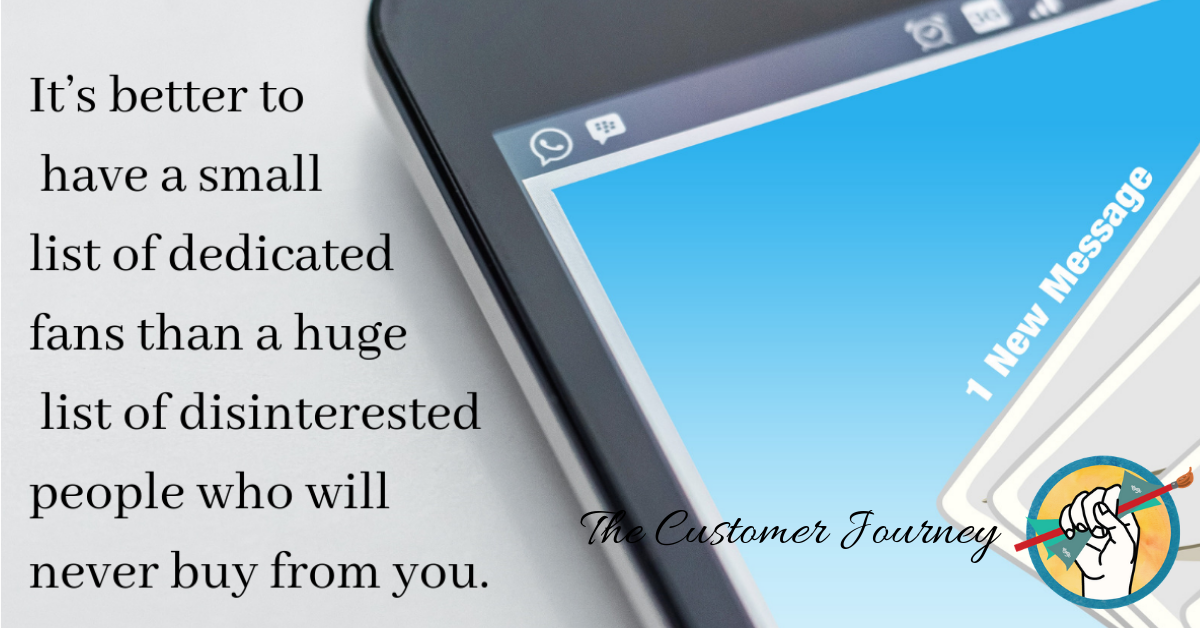
Further Buying Signals: Attending an Event
“But out of the blue I get an invitation to an event from you on Facebook, as well as a private message inviting me to the opening of your new show next month. Having been welcomed in to your world bit by bit for the past few months, I’m feeling less intimidated and more excited by the notion of an art event.”
Among your pool of fans and collectors, there is a smaller circle within who will engage with you on social media, and another circle, smaller still, who will attend events. These are the folks you will want to market to with the most fervor (like sending personalized invitations to show openings, segmenting them into a special email list that gets first-dibs on new work, etc) because these are your biggest fans and the ones most likely to progress from a smaller purchase to a large piece or even a commission.
How to leverage art events
If your customer hasn’t made a purchase yet but has been following you for some time via email and social media, an in-person event and a warm conversation with you may be just the push they need to make that first purchase. It will behoove you to polish up your sales skills so that you can engage not only with new collectors, but those who are in your “nurture sequence” both online and in real life. Here are some great pieces on cultivating good sales skills:
- Basic sales skills: active listening
- What artists can learn from a door-to-door salesman
- Your unique value proposition
Upselling: The Big Purchase.
“I type out the email and try to act real casual about asking for a $6,000 commission based on photos of old rusty farm equipment.”
Though our story is fairly straightforward and linear for the sake of illustration, real-life customers may take a much longer amount of time between the first contact and making a large purchase. This is very normal, and you can see the reality of this in your own life with just about any large purchase. Did you buy a $500 Professional KitchenAid Mixer the first time you ever saw one in robin’s-egg blue and coveted it in all its shiny lacquered cookie-mixing glory? Or did you get to use your auntie’s when you were growing up and you would spend the night, and then your best friend got a red one at her bridal shower, and then in an interim of several years you bought several smaller KitchenAid gadgets, and then one of them broke unexpectedly and you requested a replacement and had such a positive experience that when you finally received a tax return you knew just what you were going to do with it before anyone could change your mind?
The customer journey is like a recipe composed of repeat exposure, positive interactions, small purchases that are fun and easy experiences, and the slow burn of time. This is why you need to put careful thought and empathy into every aspect of your sales process, from the way you present yourself to the way you interact both in real life and on the internet. Your email marketing should be strategic and carefully planned, remembering that the people who fall in love with the artist and their whole story are the ones who will become raving fans and repeat collectors. Imagine yourself in your customer’s shoes, and think through the process of purchasing from you from their point of view. What hesitations would you have? How can you ease their fears and assure them that a purchase from you would be absolutely worth it?
How to Sell Your Art Online 101 has a very helpful workbook for identifying your ideal collector and getting inside his head.
Have you put careful thought into the customer journey in your own business? What’s one change you can make today that would make it easier for customers to make the transition from interested onlookers to repeat collectors?
This is perfect- it captures the exact mentality and concern I want to avoid about not coming off as salesy. Substituting myself in for the artist makes the journey become much clearer.
Excellent! And of course, your exact collector might vary a bit in their behavior. Glad it was helpful.
I think this was a very useful article. It provides a little more grounding in the timeline for sales. It is often disappointing to sit through an art show with very little sales, but understanding a customer needs 8 interactions before a purchase helps take away the sting.
Indeed. You just have to let the seeds germinate for a while.
Great article, very helpful thank you. I can see clearly all the things I have been doing wrong!
We can all improve in some ways. What kind of changes do you think you might make?
I kind of jumped when I read the part about being a painter of rural farm scenes. That’s me! Thanks for making this sound pertinent in so many ways.
Awesome! I’m glad it was so relevant for you!
Wonderful article! Great information. Thank you!
Thank you for writing and sharing this.
Cynthia
I loved your story!! I am an artist and I collect small original pieces when I have the money from my favorite artists…so I totally understand the journey of an art collector. But I try to base how I connect with a lot of my collectors by my sister’s buying habits of being an art collector. She buys a lot of high end art when she travels, but never follows those artists on social media or newsletters…how do you reach out to and connect with someone like that?!! So I send out twice a year physical cards of my art to my collectors…but I never hear from them. I don’t know how else to reach them…but I’m still thinking of new reactive ways! Thanks for your post!!!
The phone is great. 😉
“creative” ways!!
Even though this was a story about a made-up collector, it unexpectedly brought tears to my eyes! That deep connection between a person and your art is so incredible. Thanks for the reminder of what it feels like to be in their shoes.
I felt the same! The writing in this article is superb and sooo helpful for identifying attributes of my ideal collector. Thank you for this!
In fact I never thought about a “customer journey” of a potential collector. Why not? Because artists so often are busy with making art and not with selling. I never had a thought about what thrives a collector to a piece of art. Thank you very much for this point of view! I will no more forget it!
Thanks Ute.
This was a great read and I think a lot of artists will benefit from the mindset it reveals…thanks for posting!
Thanks Cindy. What kind of changes might you make after thinking about this?
Ok I have followed you for a while and have a question. I do historical art of the 8th army Air Force in ww2. I know the primary audience is through museums and of course they have no idea who I am. How do I make myself known without being too pushy
Thanks
Don
I found this to be very informative a hands on, instructive, practical guide to development and sales. The personal touch, stories, that was added is very helpful. I have a much better idea about how to proceed to make my shows have a better turnout. Thank you so much!
Wow, I did not expect to tear up reading this piece! Well written and explained. Thank you. As a new artist but an old social media soul, I’m aware of the online principles but reading this gave me an on-ground perspective that I will be using online as well. I definitely need to share more of my story! Thank you!